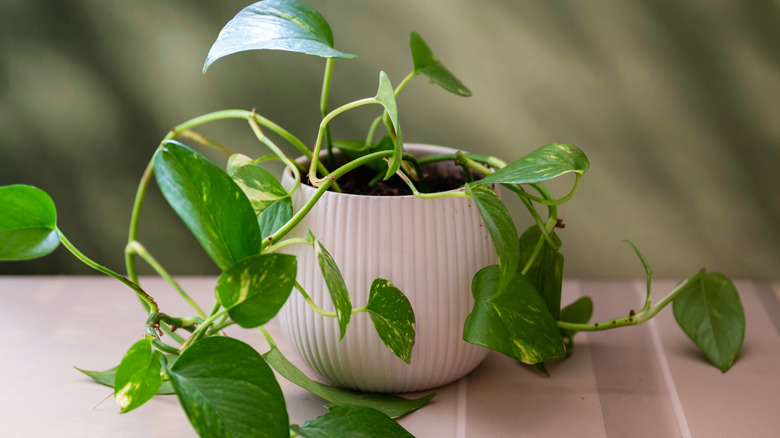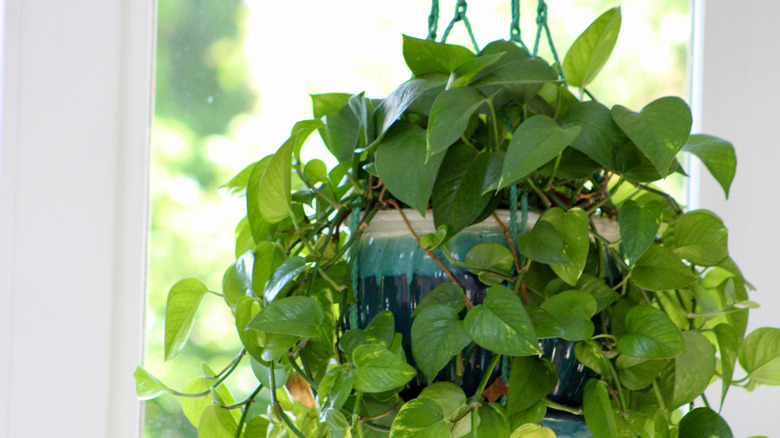For Fuller Pothos Plants Try This Clever Propagation Method
The pothos (Epipremnum aureum) is known for its easy-going nature and variegated foliage. Even though it's primarily grown inside, it can be an outdoor perennial in USDA Hardiness Zones 10 through 12. It even has a great ability to adapt and grows indoors with minimal fuss, but despite all these upsides, the one thing it doesn't do on its own is fill out the top of the plant. So, are you tired of looking at your pothos plant with long, scraggly vines and a thin-looking top? Many pothos plant-owners get frustrated when their favorite houseplant starts to look a little bald up top while the vines keep stretching towards the floor. Luckily, there's a technique you can use to make your pothos plants look fuller: the basketing method.
This process involves coiling the long vines back on to the soil in its own pot — this allows the plant's natural growth pattern to produce a fuller top by encouraging the plant to root directly from its stem nodes, which makes the plant produce new shoots and leaves at the top. This clever propagation method allows you to take advantage of the vine's structure by allowing the roots to anchor into the soil, similar to how it would naturally grow up a tree, which provides the plant with extra nutrients and stability.
How does pothos basketing work to make a plant fuller?
This is a growing technique that will improve the look of your pothos, but how does it work? To put it simply, it's due to the nodes and aerial roots found along the pothos vine. The nodes are the points on the stem where the leaves grow, and these spots can sprout new growth, including roots, in the right conditions. A pothos is a vining plant, and the vine produces tiny brown bumps at the nodes, which are dormant aerial roots. When these roots come into contact with soil, they become active. In the wild, they cling to tree bark for support and extra moisture. In your home, they are looking for stability. Basketing positions these nodes right on top of the soil when you carefully loop the long, trailing stems back up and around the inside rim of the pot. When you pin these nodes firmly down onto the dirt, they get the signal to put out new roots into the existing soil. These newly formed roots add to the overall root mass of the plant.
A larger, healthier root system can support more growth from above, which spurs the plant to send out new shoots and leaves closer to the top of the pot where the new roots are growing.This response is what changes a thin, leggy plant into one that's bushy and full. The basketing method takes advantage of the plant's natural instinct to reproduce and stabilize itself without you needing to do much more than reposition the vine.
What supplies are needed and what are the steps for pothos basketing?
To start, you'll need your pothos plant, a handful of hairpins or U-shaped wire staples, and maybe a small bag of potting mix if the soil level in your pot has sunken in. First, you should take a good look at the vine, following it from the base to the end. Find the sections that have the most pronounced nodes, since these will be the quickest to sprout new roots. Next, take the vine and coil it back toward the center of the pot, allowing the nodes to rest on top of the soil. The coil should not be so tight that it damages the vine, but snug enough that it covers some of the bare areas on top of the soil. Use the hairpins or wire staples to pin the vine down every few inches, concentrating the hairpins near the nodes. You don't want the pins to puncture the vine, just hold it in place.
After pinning, you should water your plant as you normally would, making sure the entire surface of the soil, including where the pinned vines are, gets moisture. This regular watering is what encourages the aerial roots to grow into the soil. As the roots grow, you will eventually see new leaves growing from the pinned sections, which will make the plant much fuller. Make sure to maintain a consistent routine and avoid these common watering mistakes with pothos plants.


